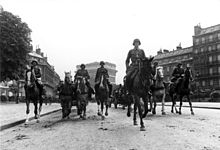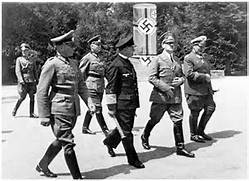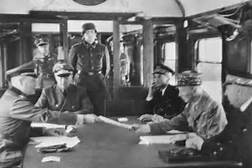1940 was one of the worst years in the history of La Belle France. After only six weeks of fighting, the Wehrmacht-Heer (The German Army) led by Field Marshall Gerd von Rundstedt, rolled up the Anglo-French armies and trapped them with their backs to the sea at the port of Dunkirk on the northwest coast. The Battle of France was over and with it, the French Republic.
Betrayed by a collaborationist government and incompetent military leadership that insisted on fighting the German invaders with WWI tactics, France capitulated on June 14th.
Rubbing the French nose in their defeat, the conquerors celebrated by strutting arrogantly in parade formation down the Champs Elysees and through the Arc de Triomphe, one of the most famous monuments in France.
The Arc honors fallen French soldiers from past wars and contains the tomb of the Unknown Soldier. Crowds of sullen, weeping Parisians, sadly looked on helplessly.
The frail, toothless “Lion of Verdun,” the malleable hero of WWI, General Henri-Philippe Petain, with a chest full of medals and billowing clouds of former glory, was trotted out as the new President of France. He hastily sued for peace as if he had any diplomatic leverage.
The Germans, barely suppressing smiles of victory, agreed. The terms were onerous.
The victors annexed the northern 3/5ths of the country, including the Atlantic coast and limited the French Army to 100,000 men. 60% of the nation’s income would go to the Reich and all French POWs would remain in German hands as slave labor. The southern two-thirds of the country would be “free” and become Vichy France.
A once proud country was carved up like a Christmas turkey.
Der Fuhrer dictated the formal French capitulation take place in Compiegne, a park north of Paris. In its center, a small railroad car is parked. The railroad car was the same spot where, twenty-two years earlier, Germany signed the Armistice ending WWI and was revered by the French as a memorial to their victory.
The irony is as rich as mother’s brownies.
Hitler intends to rub the face of France further into the excrement of defeat. He decrees that the signing ceremony be held in the same railroad car.
He and his entourage arrive ahead of the French delegation. Waffen SS soldiers form an honor guard as he approaches. His personal flag is run up on a standard in the middle of park. He strides over to the armistice car, pauses and looks around with a fierce glare of contempt, anger, hate and triumph.
He steps up into the car, followed by the others and sits in the chair occupied by Marshall Foch in 1918. The others, led by Hermann Goering, spread themselves around him. A few minutes later, the French arrive and take their place in the chairs across from the Germans. The enemies salute each other. The French are solemn and stoic. They stare straight ahead, a picture of tragic dignity.
Hitler speaks to no one.
He nods to Field Marshall Wilhelm Keitel, his chief of staff, sitting on his right. Keitel shuffles a batch of papers and begins to read the terms of the armistice. Der Fuhrer has no intention showing respect to the vanquished by lingering. After fifteen minutes, he stands, offers the Nazi salute and walks out to his awaiting car.
The honor guard band strikes up the German national anthem, “Deutschland, Deutschland uber Alles,” as he is whisked away.
Adolf Hitler has avenged 1918 in less than a quarter of an hour.



